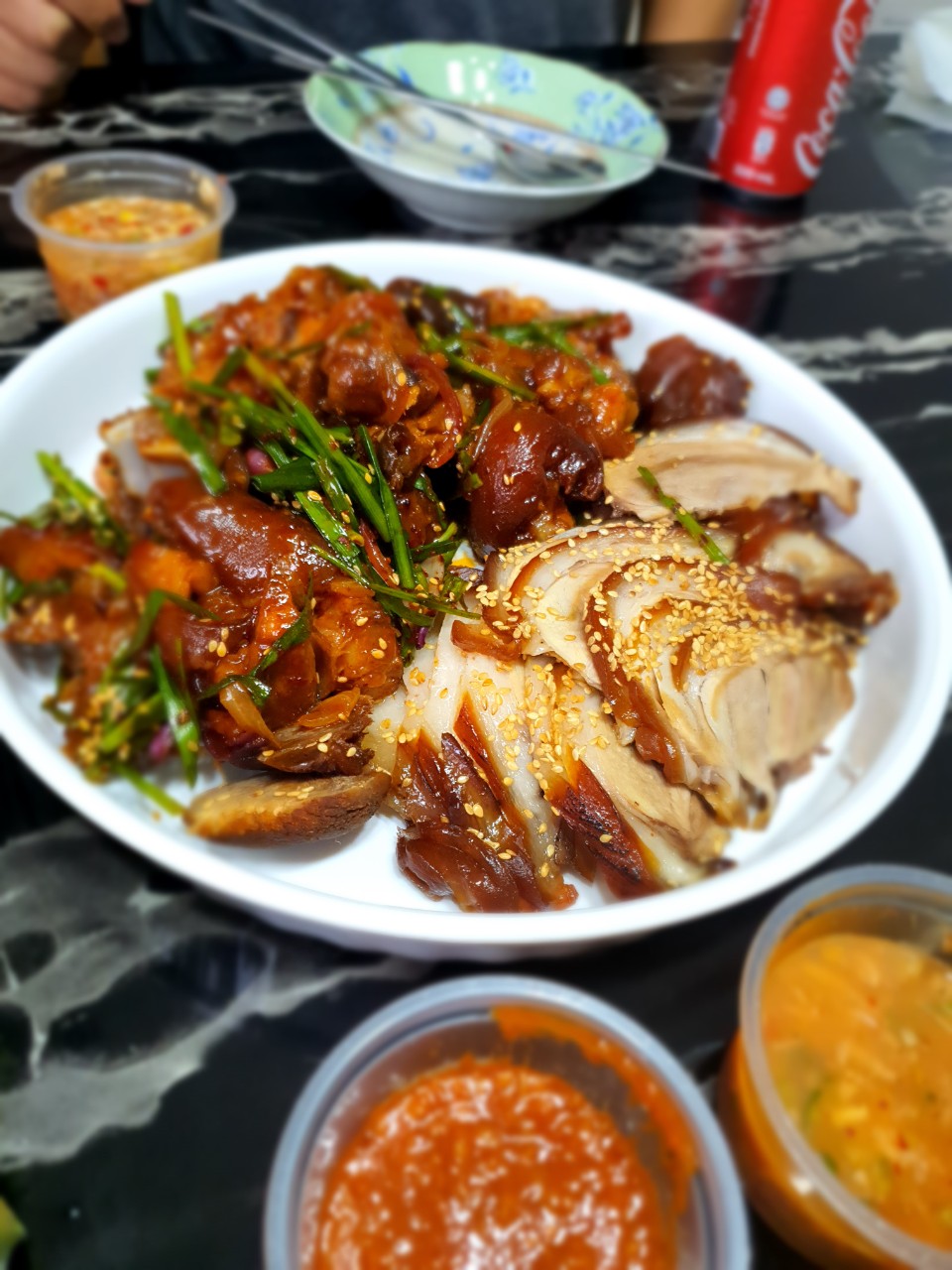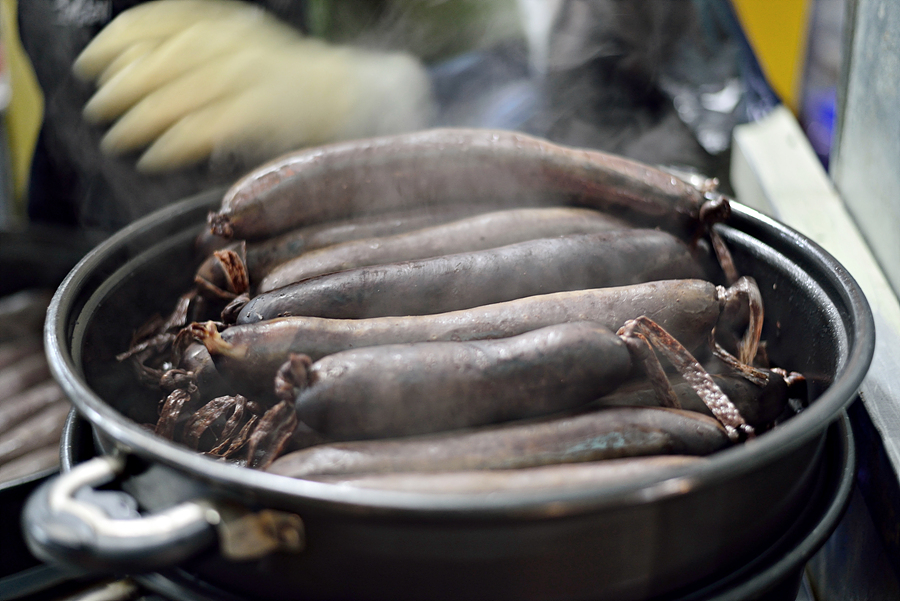|
Jeotgal
''Jeotgal'' () or ''jeot'' (), translated as salted seafood, is a category of salted preserved dishes made with seafood such as shrimps, oysters, clams, fish, and roe. Depending on the ingredients, ''jeotgal'' can range from flabby, solid pieces to clear, broth-like liquid. Solid ''jeotgal'' are usually eaten as ''banchan'' (side dishes). Liquid ''jeotgal'', called ''aekjeot'' () or fish sauce, is popularly used in kimchi seasoning, as well as in various soups and stews (''guk'', ''jijimi'', ''jjigae''). As a condiment, jeotgal with smaller bits of solid ingredients such as ''saeu-jeot'' (shrimp ''jeotgal'') is commonly served as a dipping sauce with pork dishes (''bossam'', ''jokbal'', ''samgyeopsal''), '' sundae'' (Korean sausage), '' hoe'' (raw fish), and a number of soups and stews. History Fermented foods were widely available in Three Kingdoms of Korea, as ''Sānguózhì'', a Jin Chinese historical text published in 289, mentions that the Goguryeo Koreans are skilled in ... [...More Info...] [...Related Items...] OR: [Wikipedia] [Google] [Baidu] |
Saeu-jeot
''Saeu-jeot'' * () is a variety of ''jeotgal'', salted and fermented food made with small shrimp in Korean cuisine. It is the most consumed ''jeotgal'' along with ''myeolchi-jeot'' (멸치젓, salted anchovy ''jeot'') in South Korea. The name consists of the two Korean words, ''saeu'' ( 새우 shrimp) and ''jeot''. ''Saeu-jeot'' is widely used throughout Korean cuisine but is mostly used as an ingredient in kimchi and dipping pastes. The shrimp used for making ''saeu-jeot'' are called ''jeot-saeu'' (젓새우) and are smaller and have thinner shells than ordinary shrimp. The quality of ''saeu-jeot'' largely depends on the freshness of the shrimp. In warm weather, fishermen may immediately add salt for preliminary preservation. Types The types of ''saeu-jeot'' depend on the kind of shrimp used and when they are harvested. In spring ''Putjeot'' (풋젓) is made with shrimp harvested from the end of January in lunar calendar through April. It is called ''deddeugi jeot'' (데뜨� ... [...More Info...] [...Related Items...] OR: [Wikipedia] [Google] [Baidu] |
Korean Cuisine
Korean cuisine has evolved through centuries of social and political change. Originating from ancient agricultural and nomadic traditions in Korea and southern Manchuria, Korean cuisine reflects a complex interaction of the natural environment and different cultural trends. Korean cuisine is largely based on rice, vegetables, seafood and (at least in South Korea) meats. Dairy is largely absent from the traditional Korean diet. Traditional Korean meals are named for the number of side dishes (반찬; 飯饌; ''banchan'') that accompany steam-cooked short-grain rice. Kimchi is served at nearly every meal. Commonly used ingredients include sesame oil, ''doenjang'' (fermented bean paste), soy sauce, salt, garlic, ginger, ''gochugaru'' (pepper flakes), '' gochujang'' (fermented red chili paste) and napa cabbage. Ingredients and dishes vary by province. Many regional dishes have become national, and dishes that were once regional have proliferated in different variations ... [...More Info...] [...Related Items...] OR: [Wikipedia] [Google] [Baidu] |
Kimchi
''Kimchi'' (; ko, 김치, gimchi, ), is a traditional Korean side dish of salted and fermented vegetables, such as napa cabbage and Korean radish. A wide selection of seasonings are used, including ''gochugaru'' (Korean chili powder), spring onions, garlic, ginger, and ''jeotgal'' (salted seafood), etc. Kimchi is also used in a variety of soups and stews. As a staple food in Korean cuisine, it is eaten as a side dish with almost every Korean meal. There are hundreds of different types of kimchi made with different vegetables as the main ingredients. Traditionally, winter kimchi, called kimjang, was stored in large earthenware fermentation vessels, called ''onggi'', in the ground to prevent freezing during the winter months and to keep it cool enough to slow down the fermentation process during summer months. The vessels are also kept outdoors in special terraces called jangdokdae. In contemporary times, household kimchi refrigerators are more commonly used. Etymology ... [...More Info...] [...Related Items...] OR: [Wikipedia] [Google] [Baidu] |
Shiokara
, is a food in Japanese cuisine made from various marine animals that consists of small pieces of meat in a brown viscous paste of the animal's heavily salted, fermented viscera. The raw viscera are mixed with about 10% salt, 30% malted rice, packed in a closed container, and fermented for up to a month. ''Shiokara'' is sold in glass or plastic containers. The flavor is similar in saltiness and fishiness to that of European cured anchovies, but with a different texture. One of the best-known ''chinmi'' ("rare tastes"), it is quite strong and is considered something of an acquired taste even for the native Japanese palate. It was a valuable protein in post-war Japan because food was scarce and it did not require refrigeration. It continued to be eaten as a condiment for rice and in bars. One method of enjoying it is to consume the serving in one gulp and to follow it with a shot of straight whisky. Some bars in Japan specialize in ''shiokara''. Some types of ''shiokara'' * I ... [...More Info...] [...Related Items...] OR: [Wikipedia] [Google] [Baidu] |
Jokbal
''Jokbal''(족발) is a Korean dish consisting of pig's trotters cooked with soy sauce and spices.Jokbal at It is usually braised in a combination of soy sauce, ginger, garlic, and rice wine. Additional ingredients used can include onion, leeks, garlic, cinnamon and black pepper. History Jokbal is presumed to have originated from braised pork, a local food of Hwanghae-do, where pigs' legs are boiled. The current jokbal is a food that started in Jangchung-dong in the 1960s, and is known to have been developed by grandmothers from Pyeongan-do and Hwanghae-do for a living. In the 1960s and 1970s, it began to be widely known through visitors to ...[...More Info...] [...Related Items...] OR: [Wikipedia] [Google] [Baidu] |
Jjigae
''Jjigae'' (Korean: 찌개, ) is a Korean stew. There are many varieties; it is typically made with meat, seafood or vegetables in a broth seasoned with ''gochujang'' (red chilli paste), ''doenjang'' (soy bean paste), ''ganjang'' (soy sauce) or ''saeujeot'' (salted seafood).Jjigae at ''Jjigae'' is usually served in a communal dish, boiling hot. A Korean meal almost always includes either a ''jjigae'' or a ''''. During the dynasty, it was known as ''jochi'', and two v ... [...More Info...] [...Related Items...] OR: [Wikipedia] [Google] [Baidu] |
Standard Korean Language Dictionary
''Standard Korean Language Dictionary'' () is a dictionary of the Korean language, published by the National Institute of Korean Language. History The compilation of Standard Korean Language Dictionary was commenced on 1 January 1992, by The National Academy of the Korean Language, the predecessor of the National Institute of Korean Language. The dictionary's first edition was published in three volumes on 9 October 1999, followed by the compact disc released on 9 October 2001. The online dictionary was launched on 9 October 2002, and revised on 9 October 2008. See also * Basic Korean Dictionary References 1999 non-fiction books Korean language Korean dictionaries Online dictionaries {{Dictionary-stub ... [...More Info...] [...Related Items...] OR: [Wikipedia] [Google] [Baidu] |
Condiment
A condiment is a preparation that is added to food, typically after cooking, to impart a specific Flavoring, flavor, to enhance the flavor, or to complement the dish. A table condiment or table sauce is more specifically a condiment that is served separately from the food and is added to taste by the diner. Condiments are sometimes added prior to serving, for example, in a sandwich made with ketchup, mustard (condiment), mustard or mayonnaise. Some condiments are used during cooking to add flavor or texture: barbecue sauce, compound butter, Teriyaki#Teriyaki sauce, teriyaki sauce, soy sauce, Marmite and sour cream are examples. Many condiments, such as mustard or ketchup, are available in Packet (container), single-serving packets, commonly when supplied with take-out or fast food meals. Definition The exact definition of a condiment varies. Some definitions encompass Spice, spices and Herb, herbs, including salt and pepper, using the term interchangeably with ''seasoning''. O ... [...More Info...] [...Related Items...] OR: [Wikipedia] [Google] [Baidu] |
Bossam
''Bossam'' (, 褓-) is a pork dish in Korean cuisine. It usually consists of pork shoulder that is boiled in spices and thinly sliced. The meat is served with side dishes such as spicy radish salad, sliced raw garlic, ''ssamjang'' (wrap sauce), ''saeu-jeot'' (salted shrimp), kimchi, and ''ssam'' (wrap) vegetables such as lettuce, ''kkaennip'' (perilla leaves), and inner leaves of a napa cabbage. ''Bossam'' is a popular dish in South Korea, often served as '' anju'' (i.e. food accompanying alcoholic drinks). To eat, the meat and side dishes are wrapped together in ''ssam'' vegetables, hence the literal meaning of ''bossam'': "wrapped" or "packaged". History ''Bossam'' is traditionally linked with the process of '' gimjang'', during which large quantities of kimchi are prepared for winters. To ensure the commitment of the workers during this labor-intensive process, ''yangban'' (scholar-gentry of the Joseon era) would deliver a pig for a feast. The workers would enjoy boiled pork ... [...More Info...] [...Related Items...] OR: [Wikipedia] [Google] [Baidu] |
Samgyeopsal
''Samgyeopsal'' (; ), ''samgyeopsal-gui'' ( ), or grilled pork belly is a type of ''gui'' (grilled dish) in Korean cuisine. Etymology Directly translated from Korean, ''samgyeop-sal'' () means "three layer flesh," referring to striations of lean meat and fat in the pork belly that appear as three layers when cut. It is the part of the abdomen under the loin from the 5th rib or 6th rib to the hind limb. In Korea, the word ''samgyeop-sal,'' meaning "pork belly", often refers to ''samgyeop-sal-gui'' (grilled pork belly), in the same way that the word ''galbi,'' meaning "ribs", often refers to ''galbi-gui'' (grilled beef ribs). ''Gui'' refers to roasted, baked, or grilled dishes. One can also find ''ogyeopsal'' (), with an ''o'' meaning "five" and "gyeop" meaning a layer. ''Ogyeop-sal'' includes the skin part of the pork belly, unlike ''samgyeop-sal'' where the skin is removed. History The first mention of the meat dish was in a ''Donga-ilbo'' article published on November 3 ... [...More Info...] [...Related Items...] OR: [Wikipedia] [Google] [Baidu] |
Sundae (Korean Food)
''Sundae'' ( ko, 순대 , sometimes anglicized as ''soondae'') is a type of blood sausage in Korean cuisine. It is a popular street food in both North and South Korea, generally made by steaming cow or pig's intestines stuffed with various ingredients. History The ''sundae'' sausage dates back to the Goryeo period (918–1392), when wild boars, prominent across the Korean Peninsula, were used in the dish. Recipes for ''sundae'' are found in nineteenth century cookbooks including ''Gyuhap chongseo'' and ''Siuijeonseo''. Traditional ''sundae'', cow or pig intestines stuffed with ''seonji'' (blood), minced meats, rice, and vegetables, was an indulgent food consumed during special occasions, festivities and large family gatherings. After the Korean War, when meat was scarce during the period of post-war poverty, ''dangmyeon'' replaced meat fillings in South Korea. ''Sundae'' became an inexpensive street snack sold in ''bunsikjip'' (snack bars), ''pojangmacha'' (street stalls), ... [...More Info...] [...Related Items...] OR: [Wikipedia] [Google] [Baidu] |

.jpg)


.jpg)
